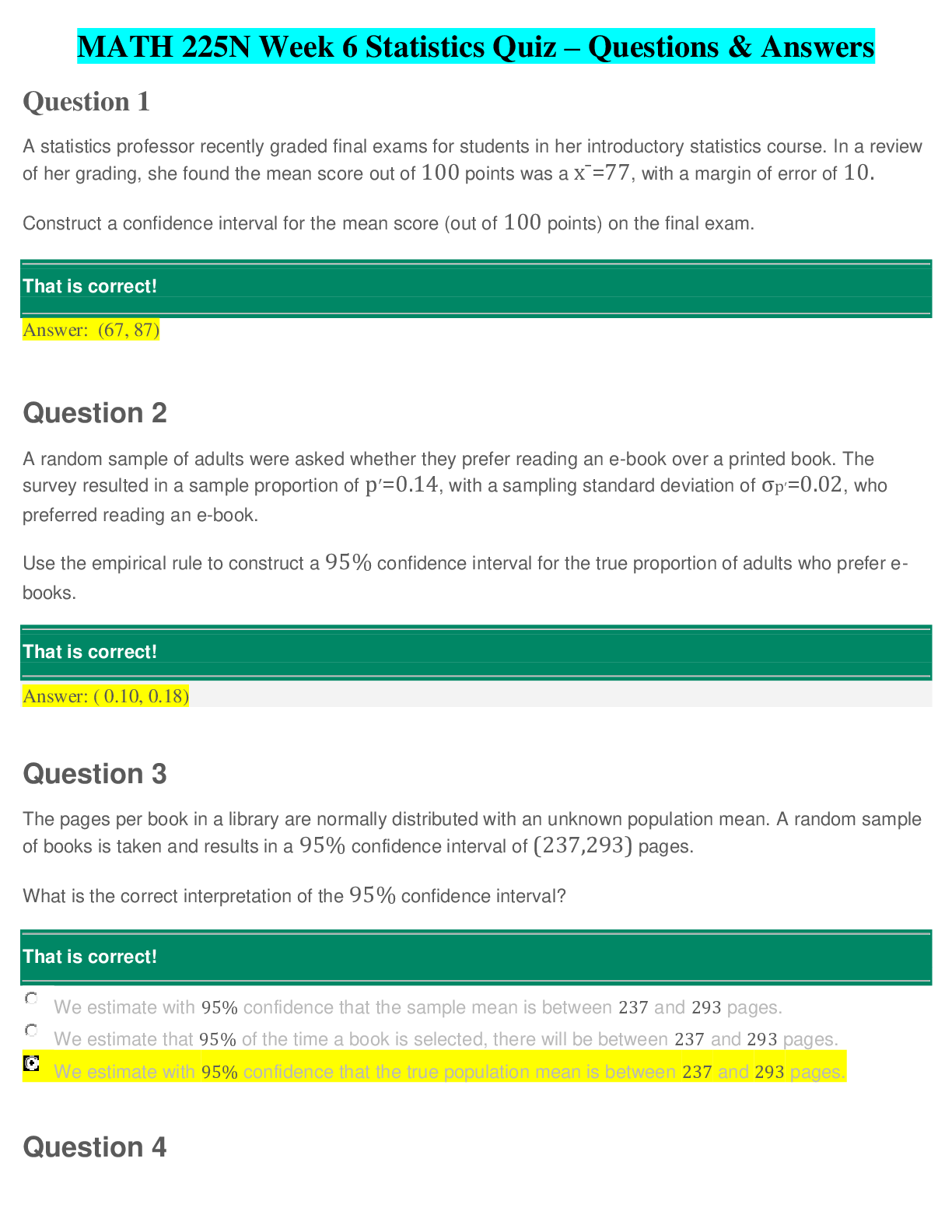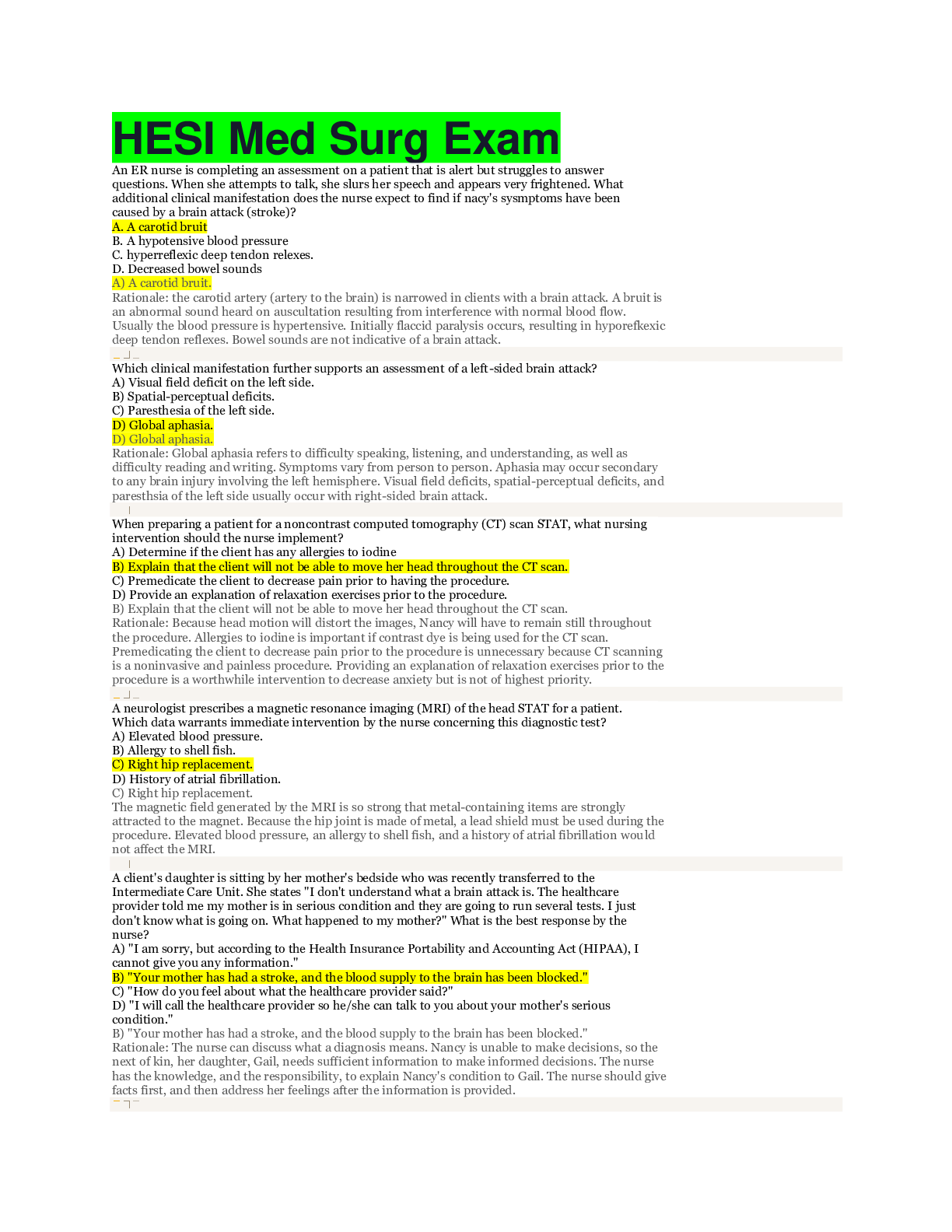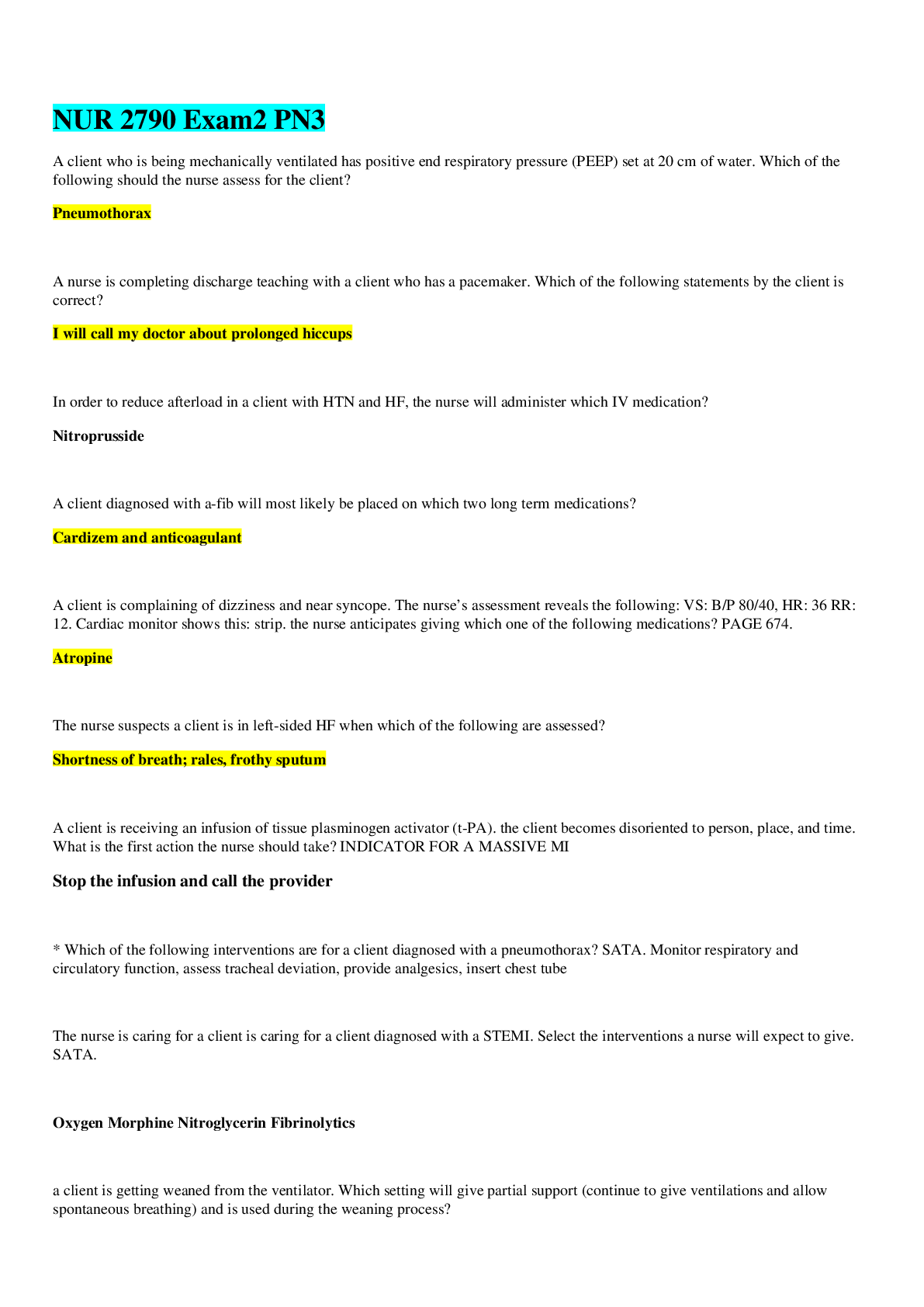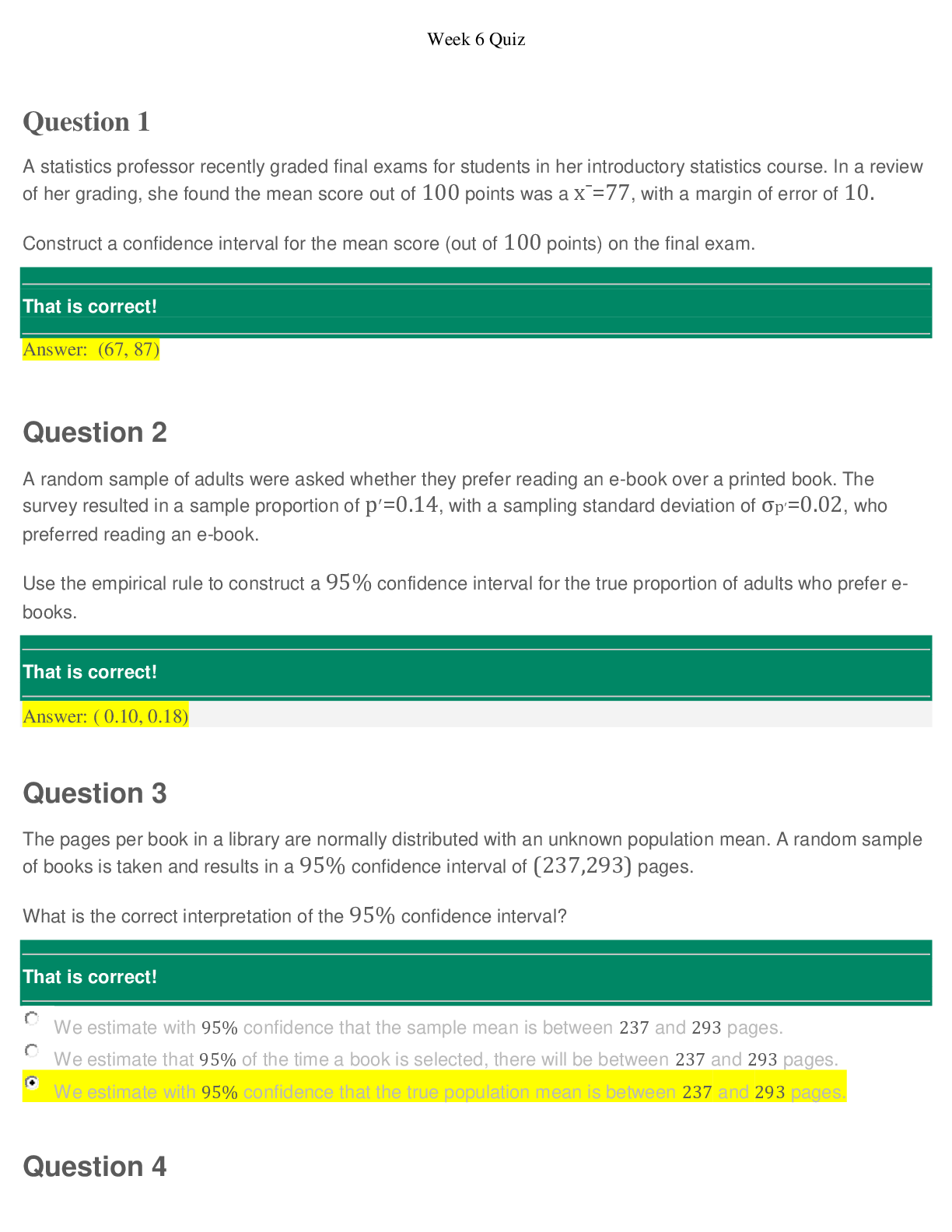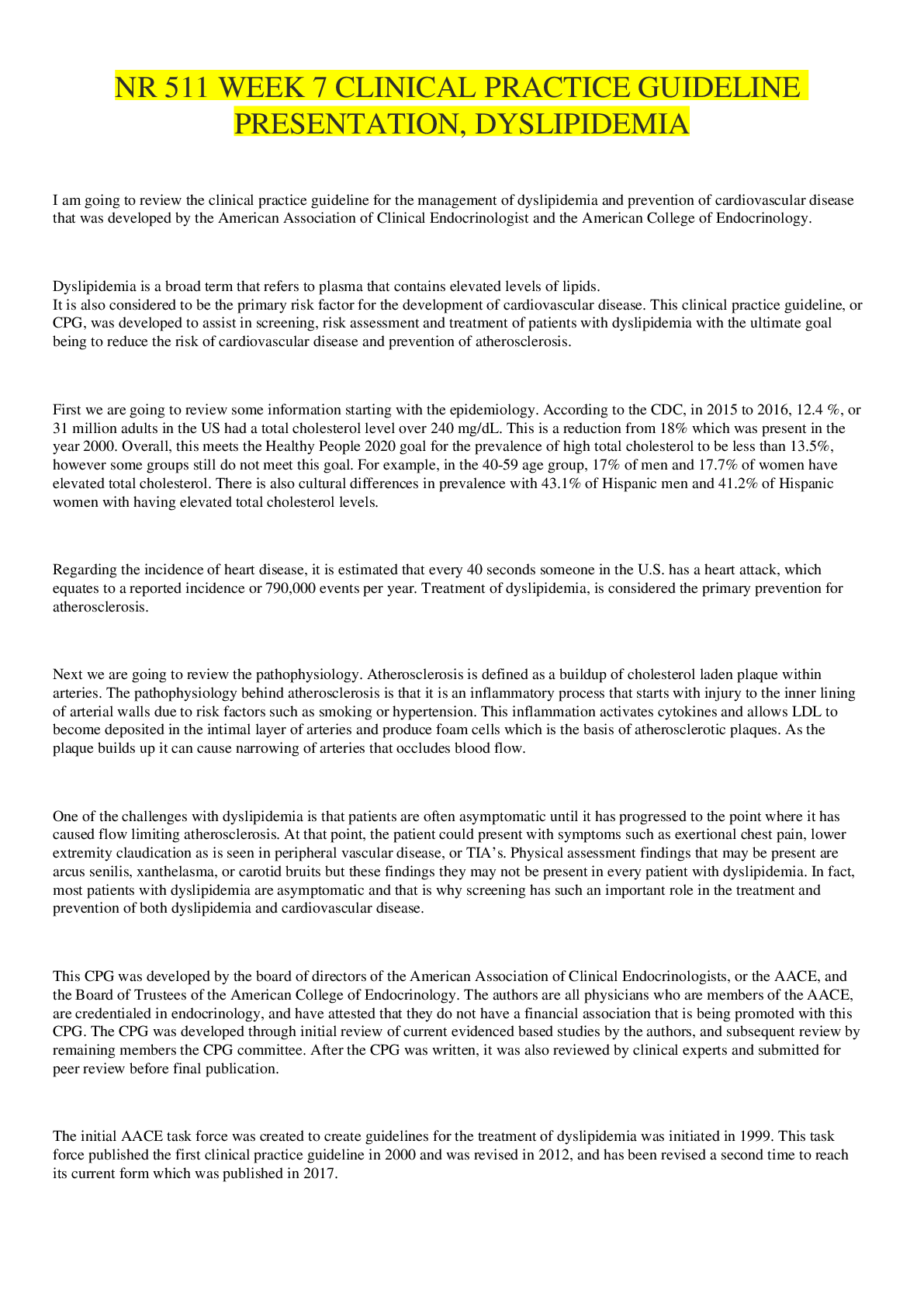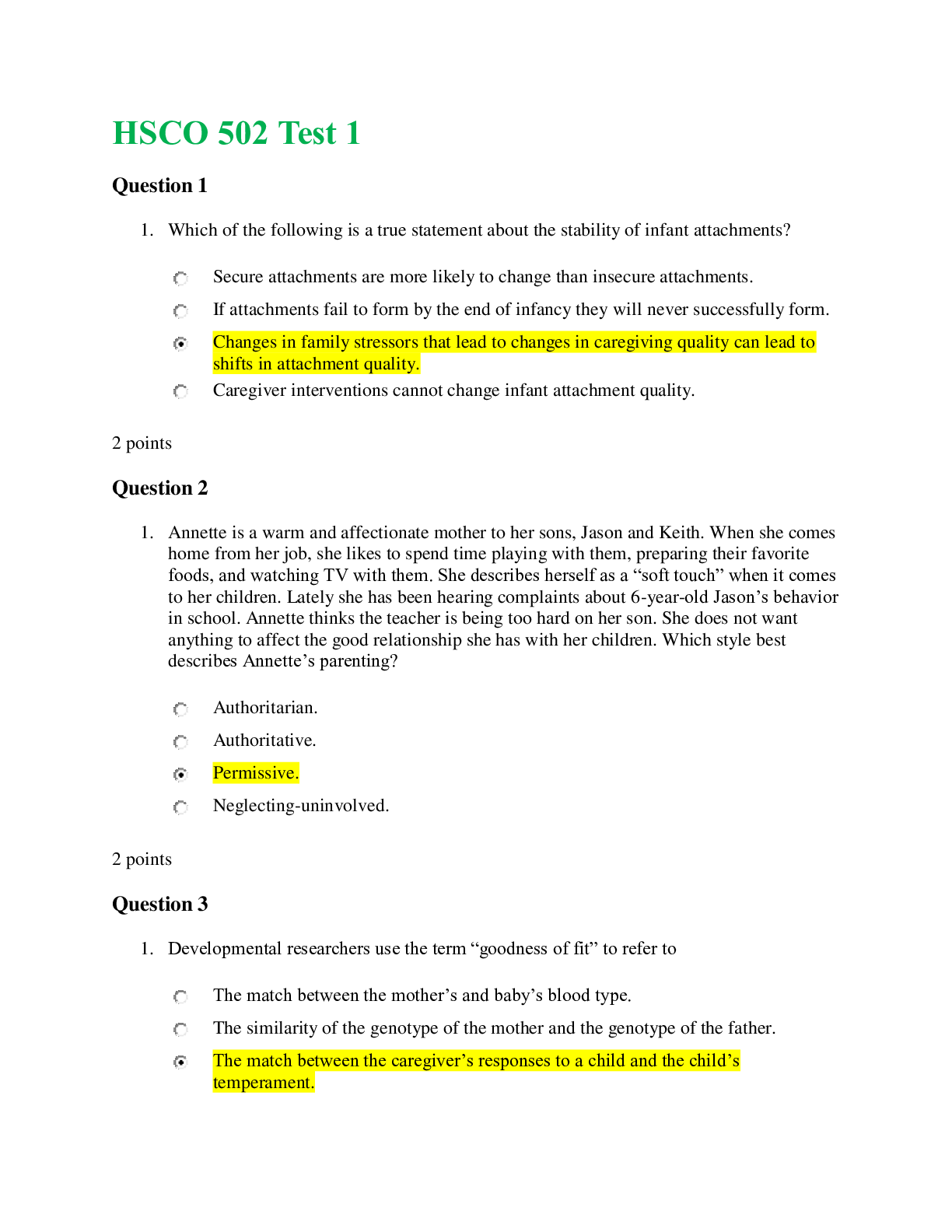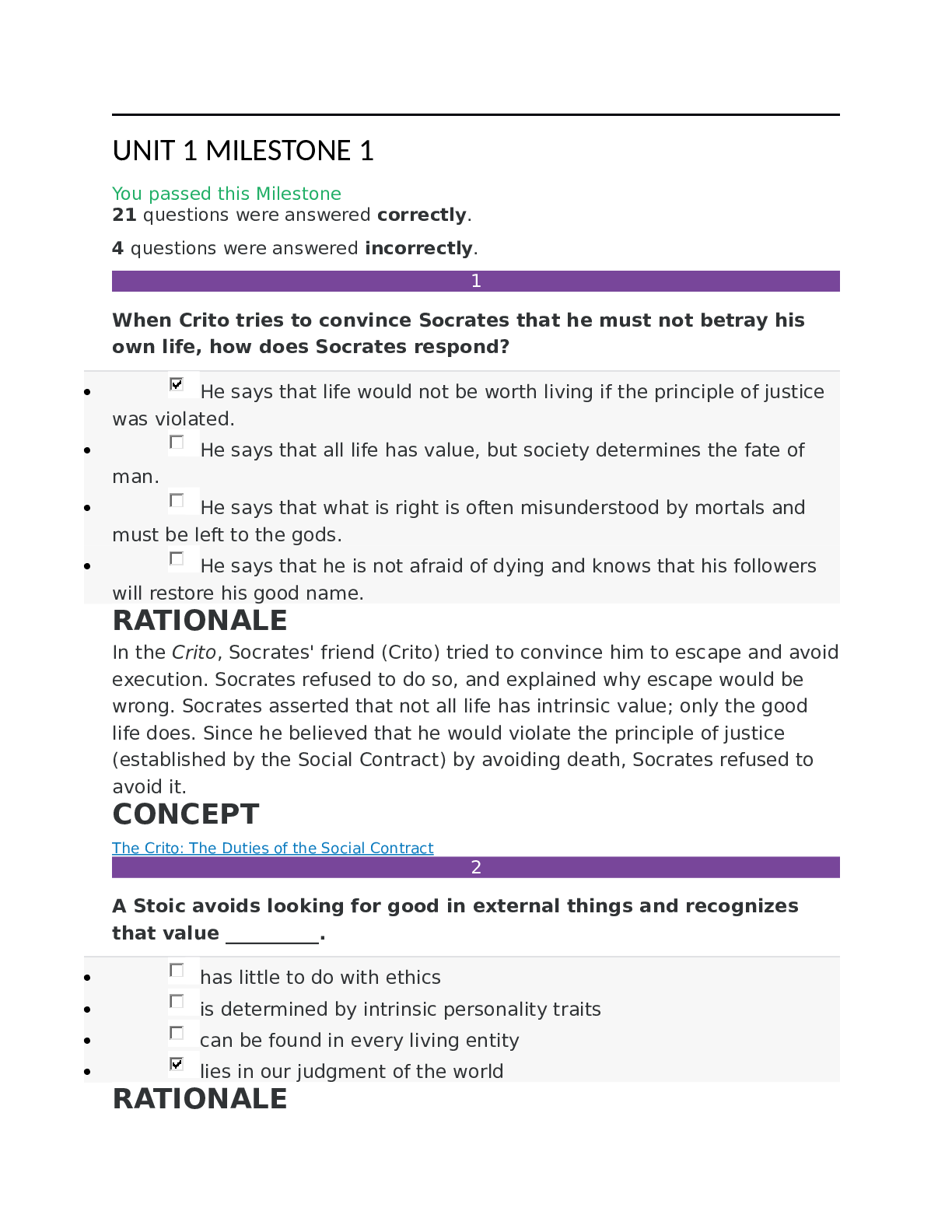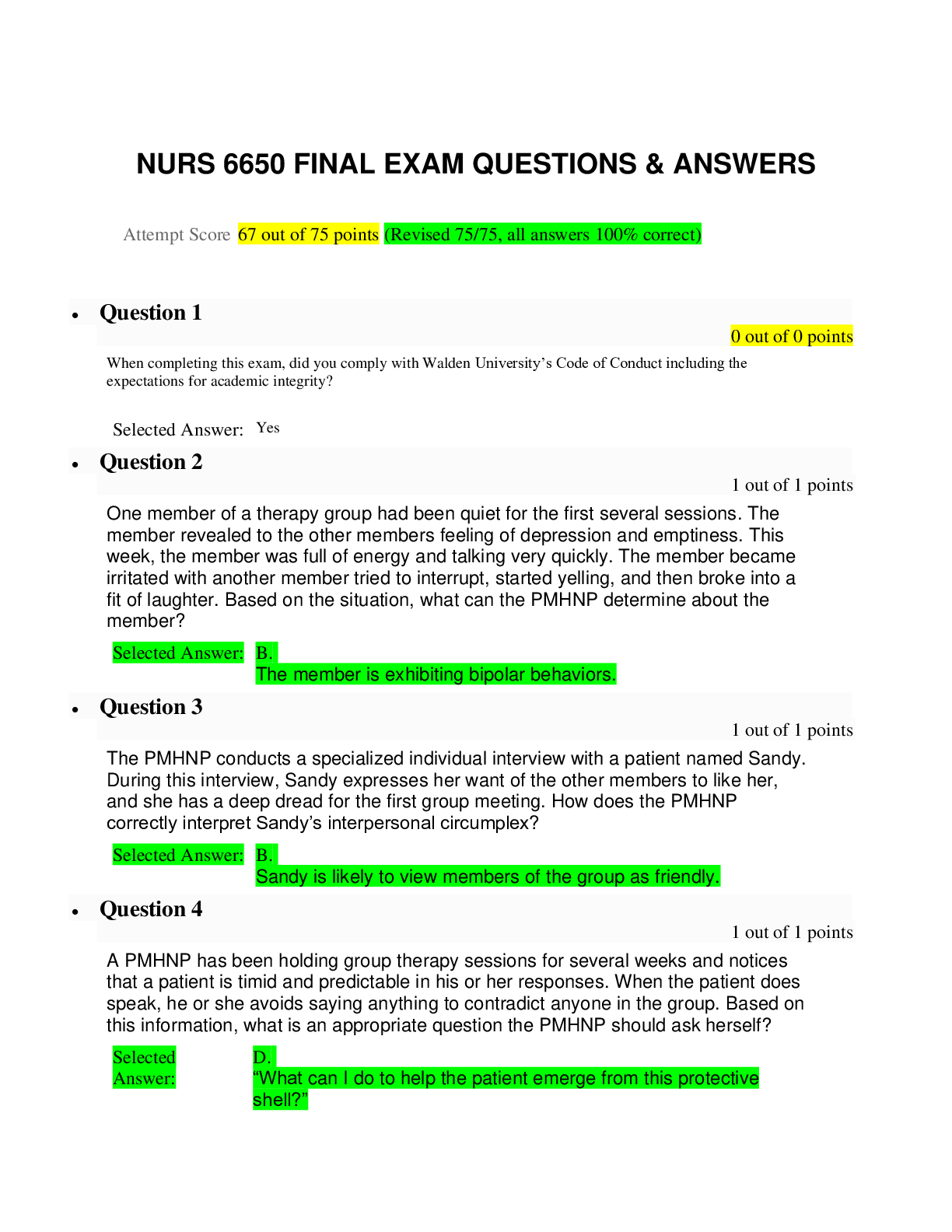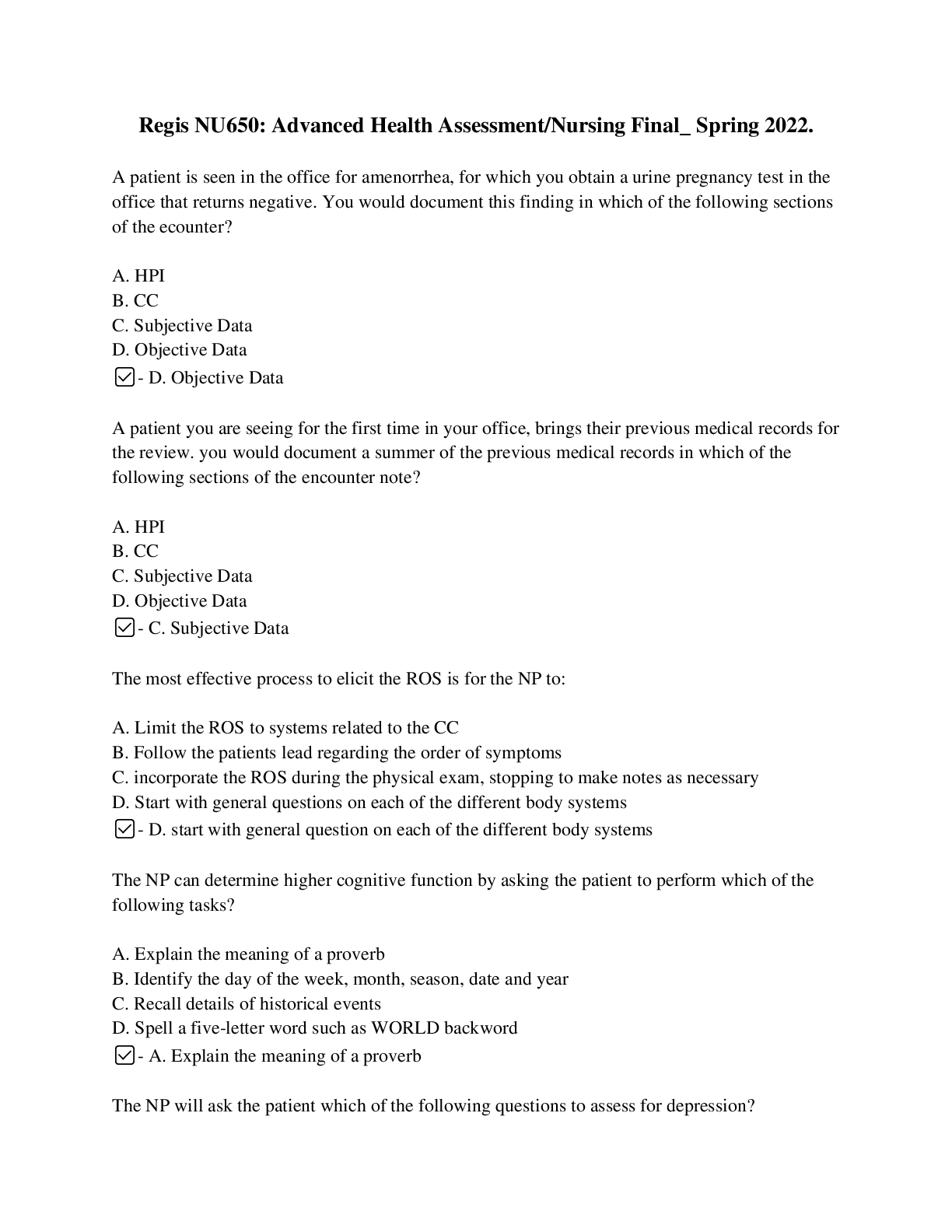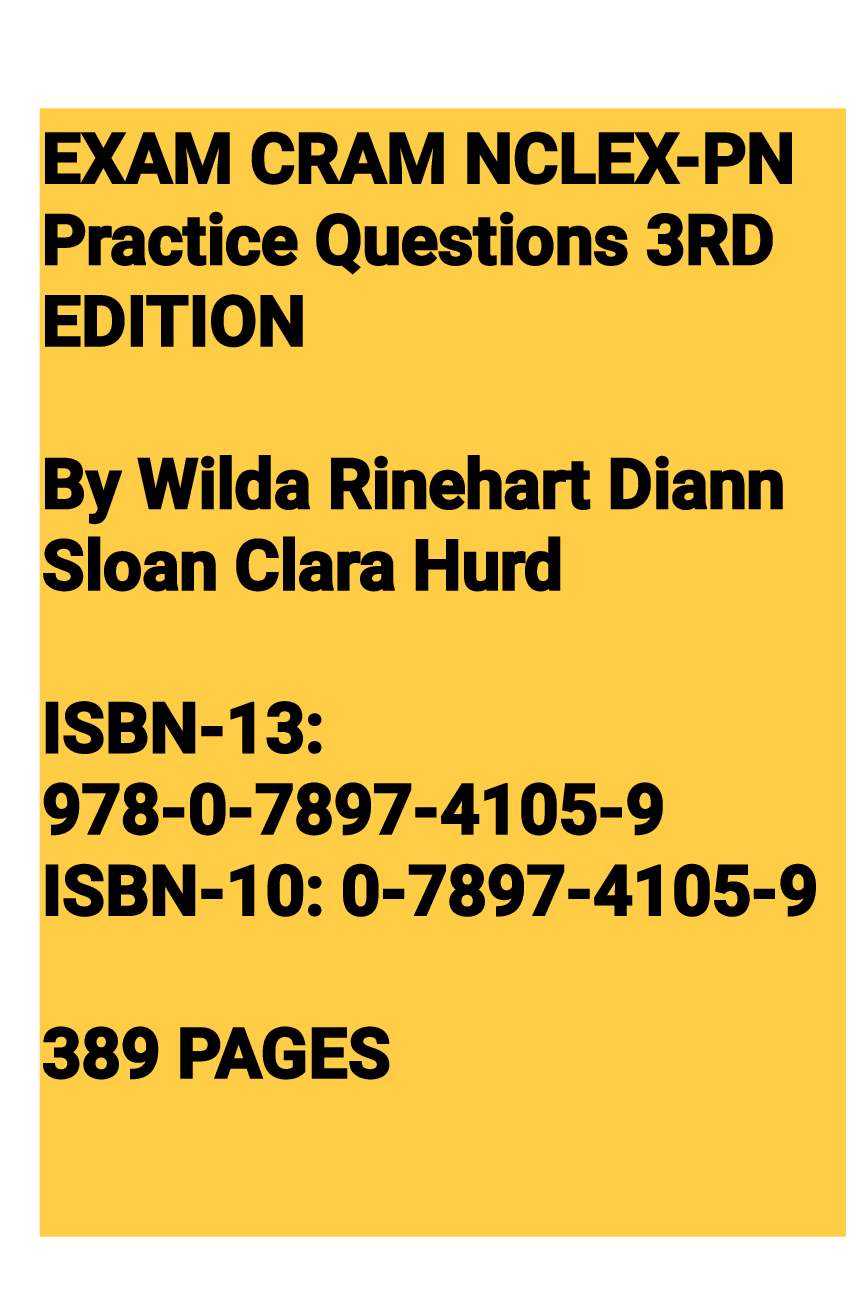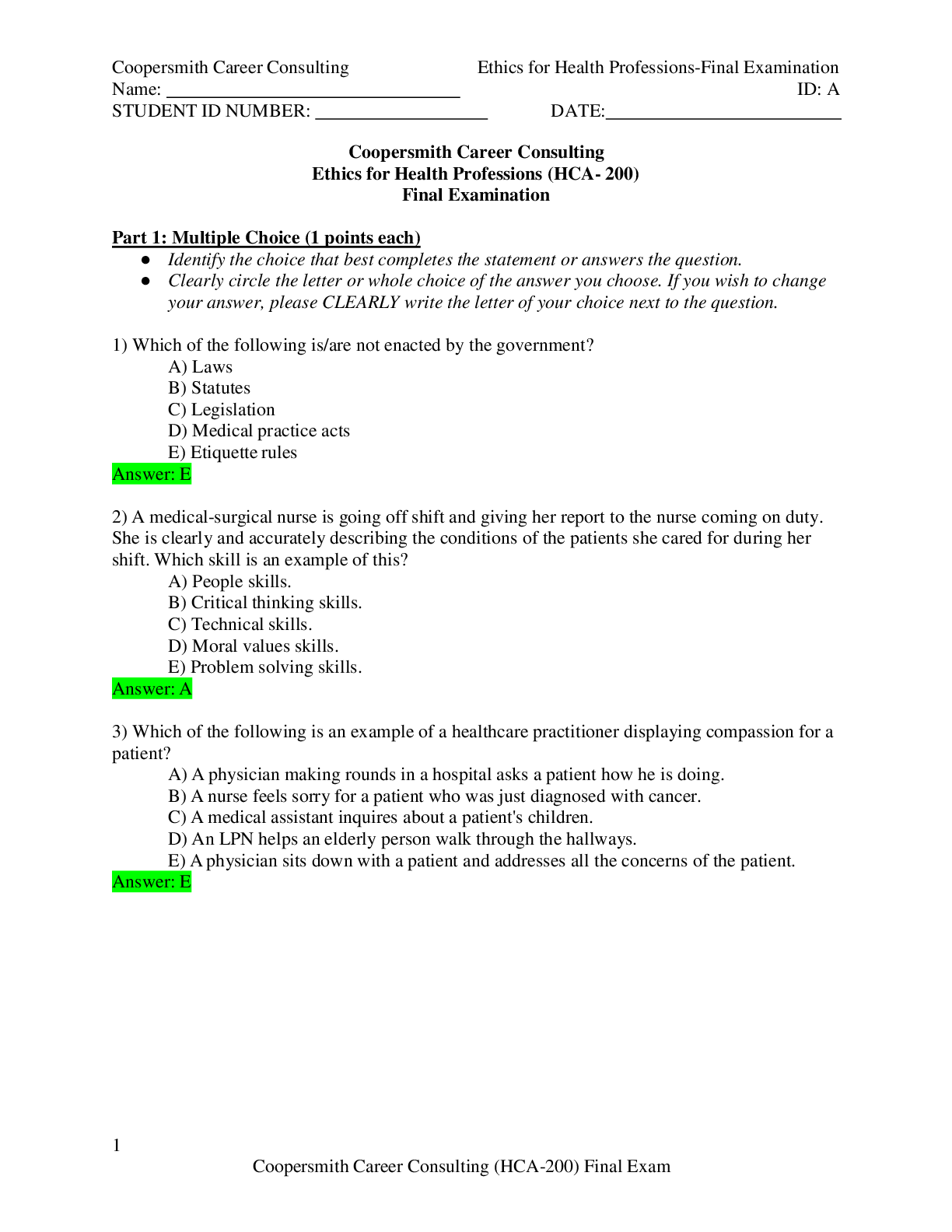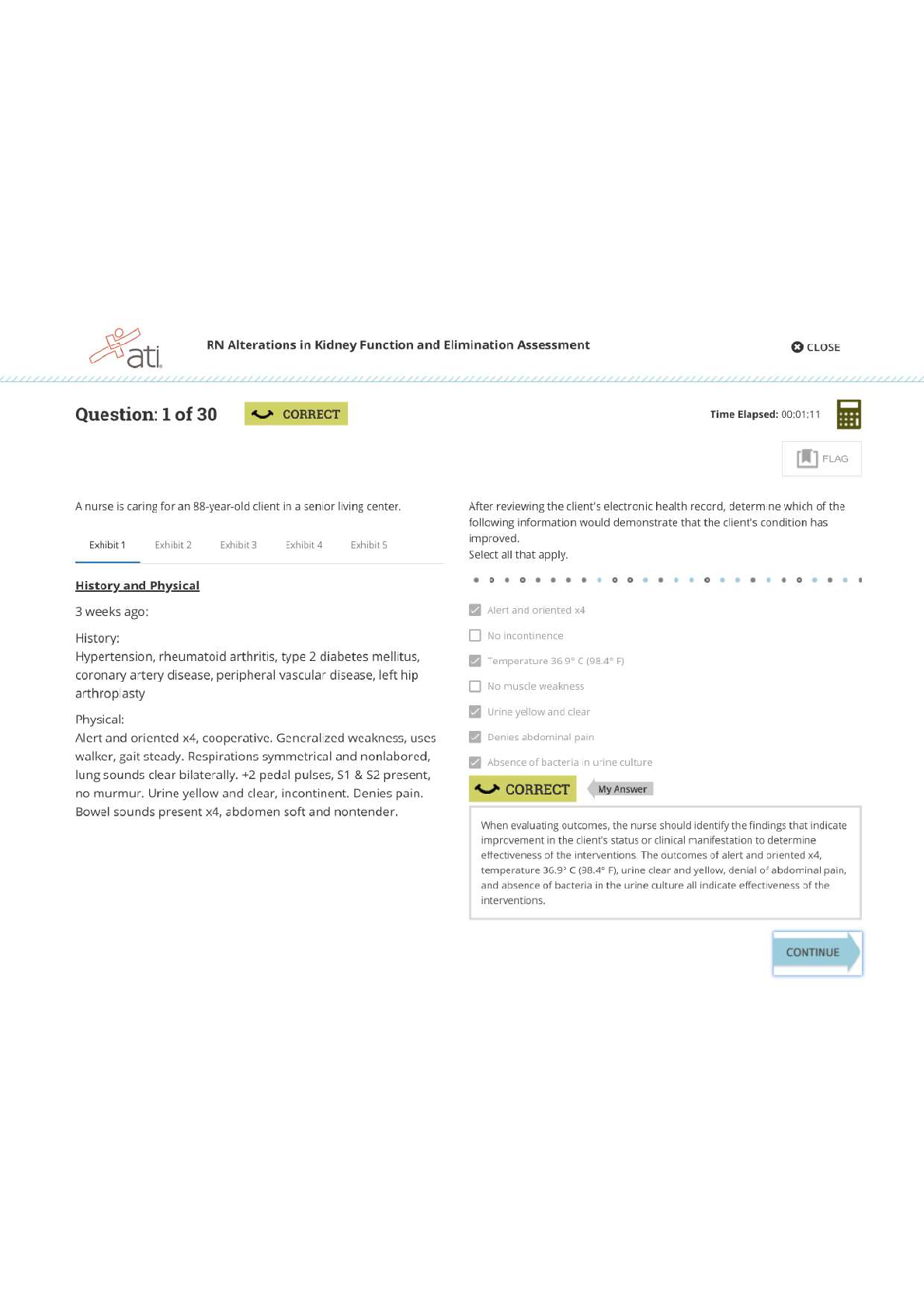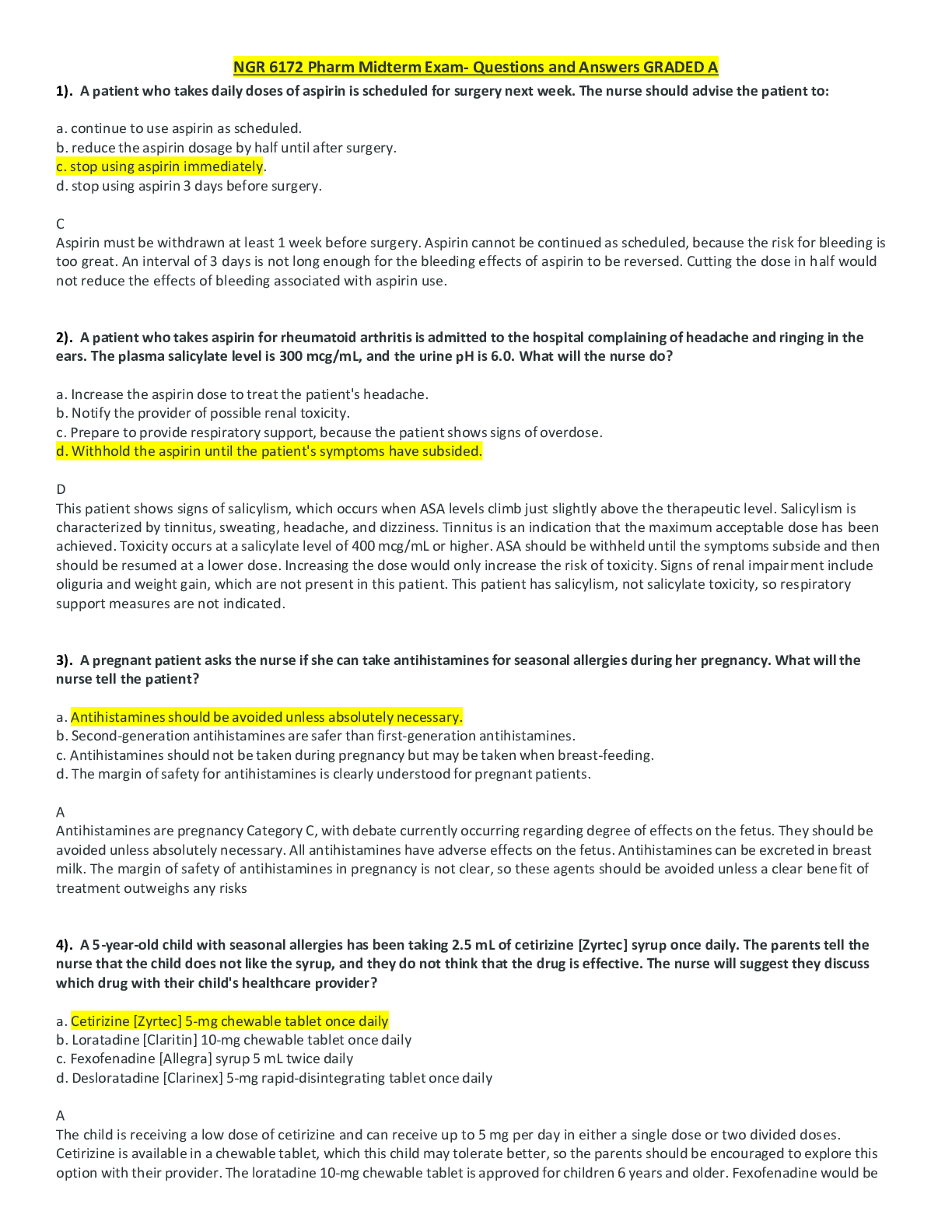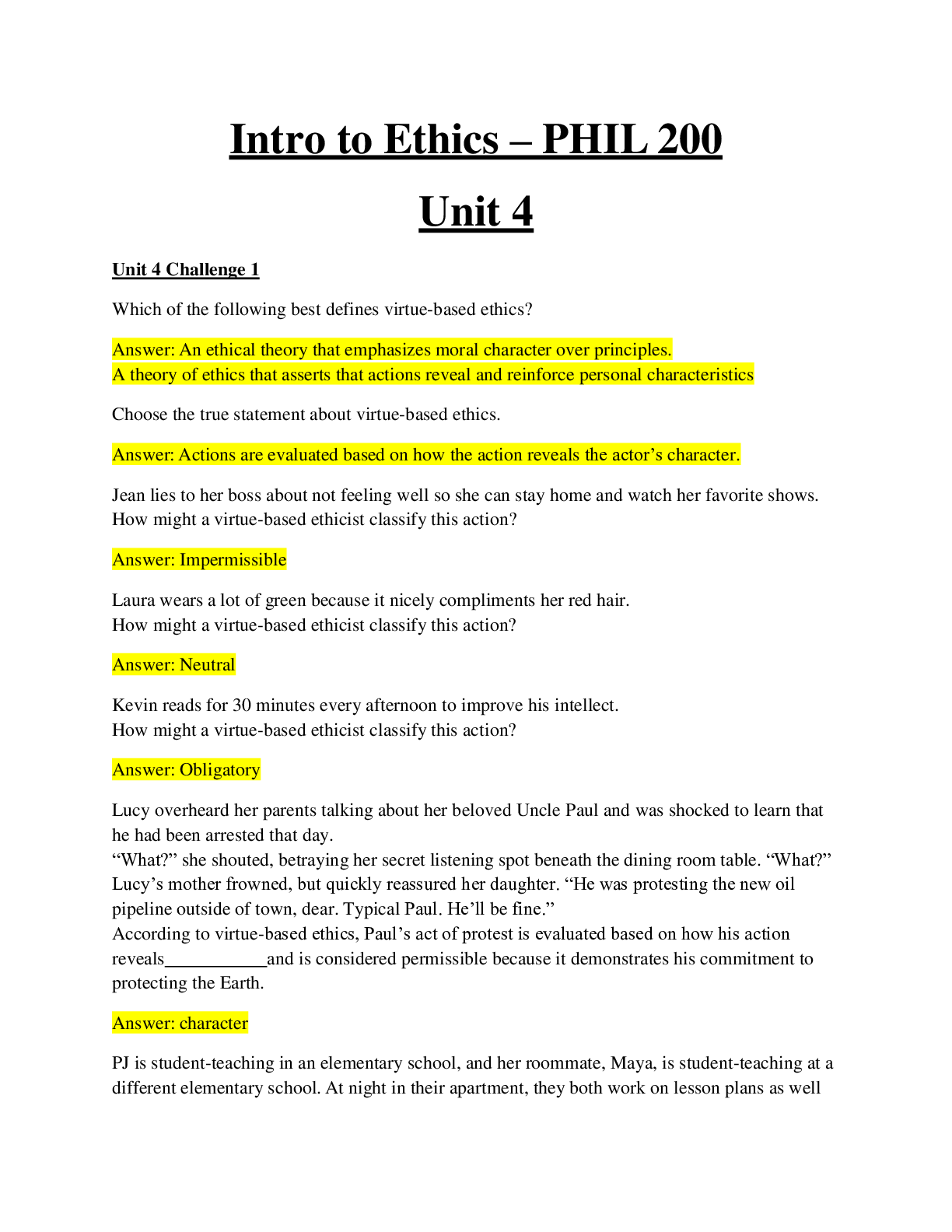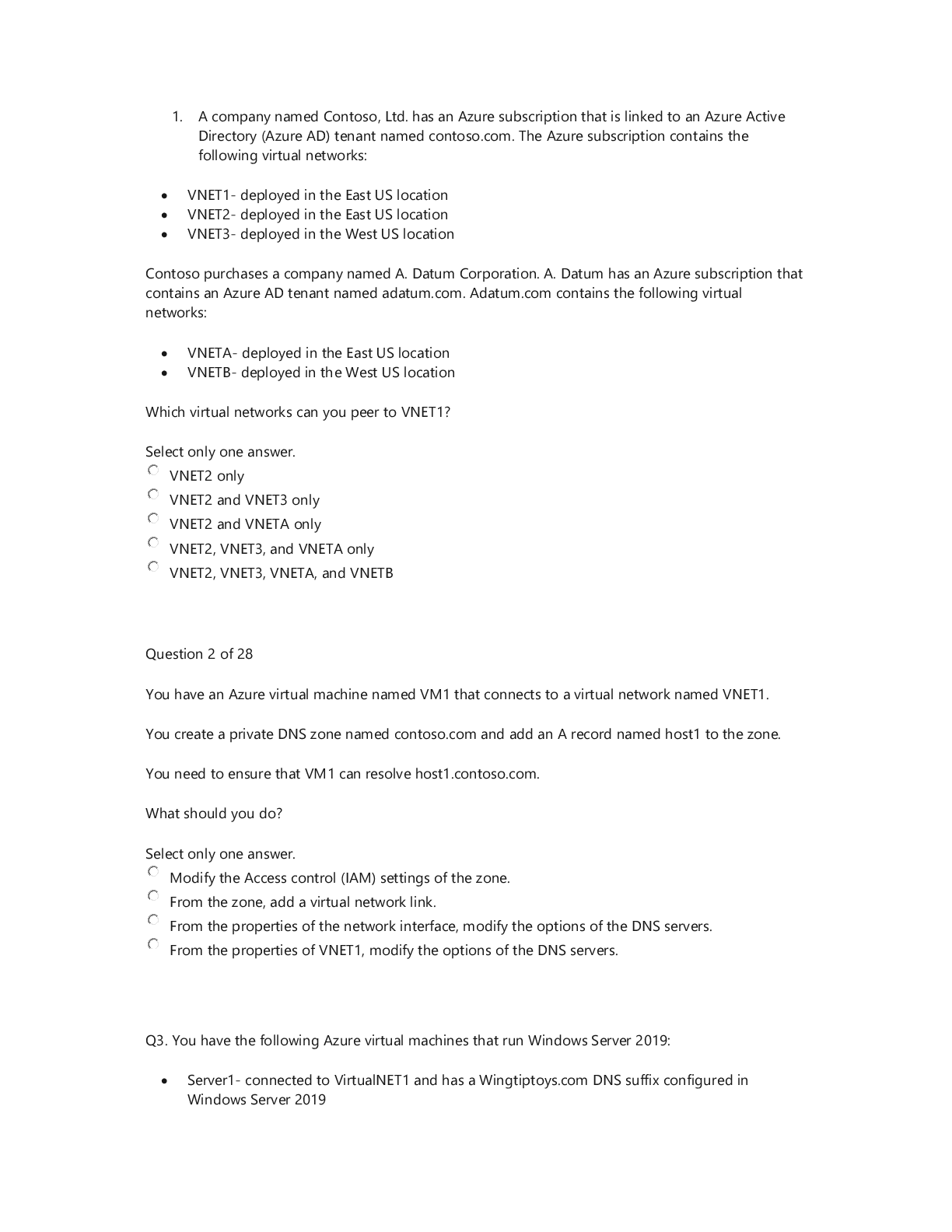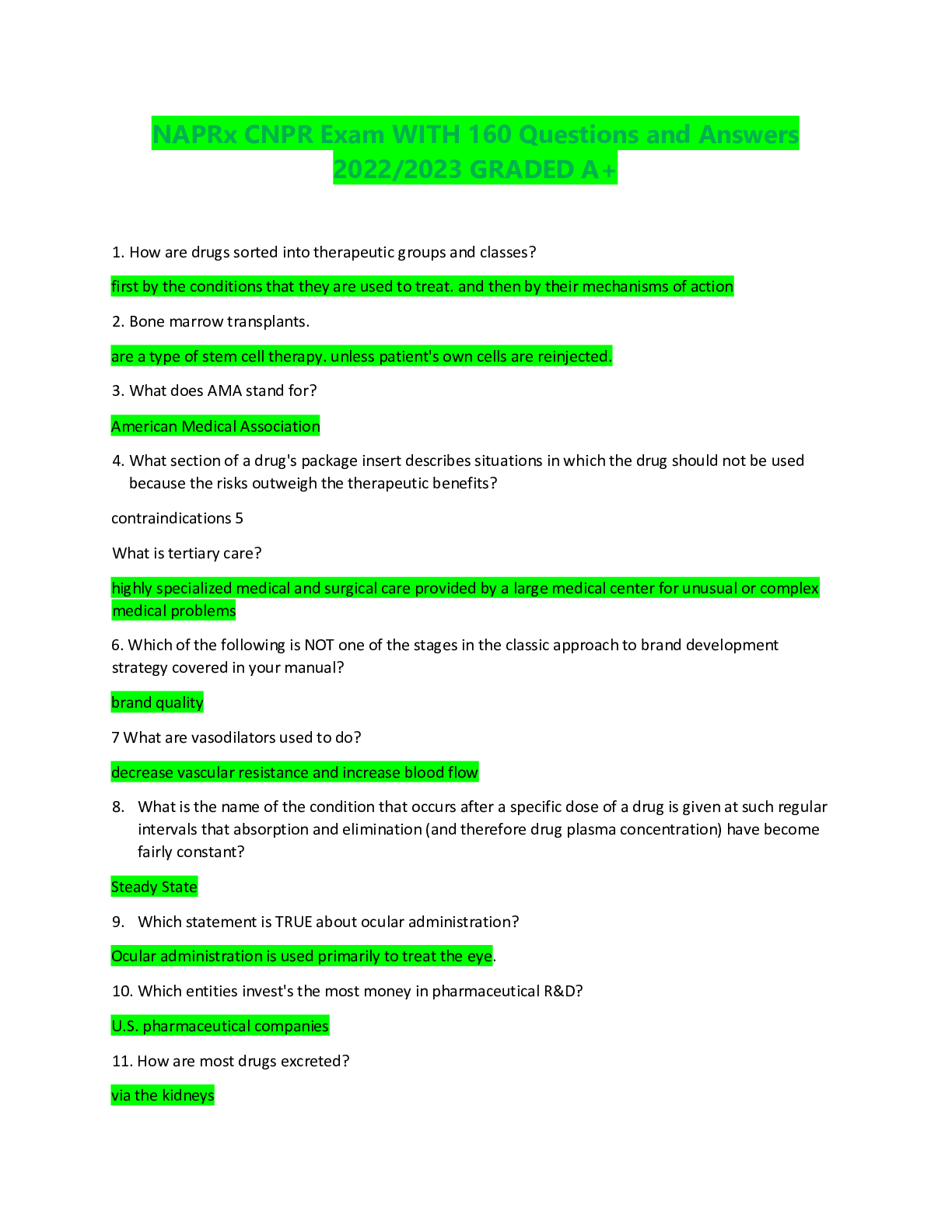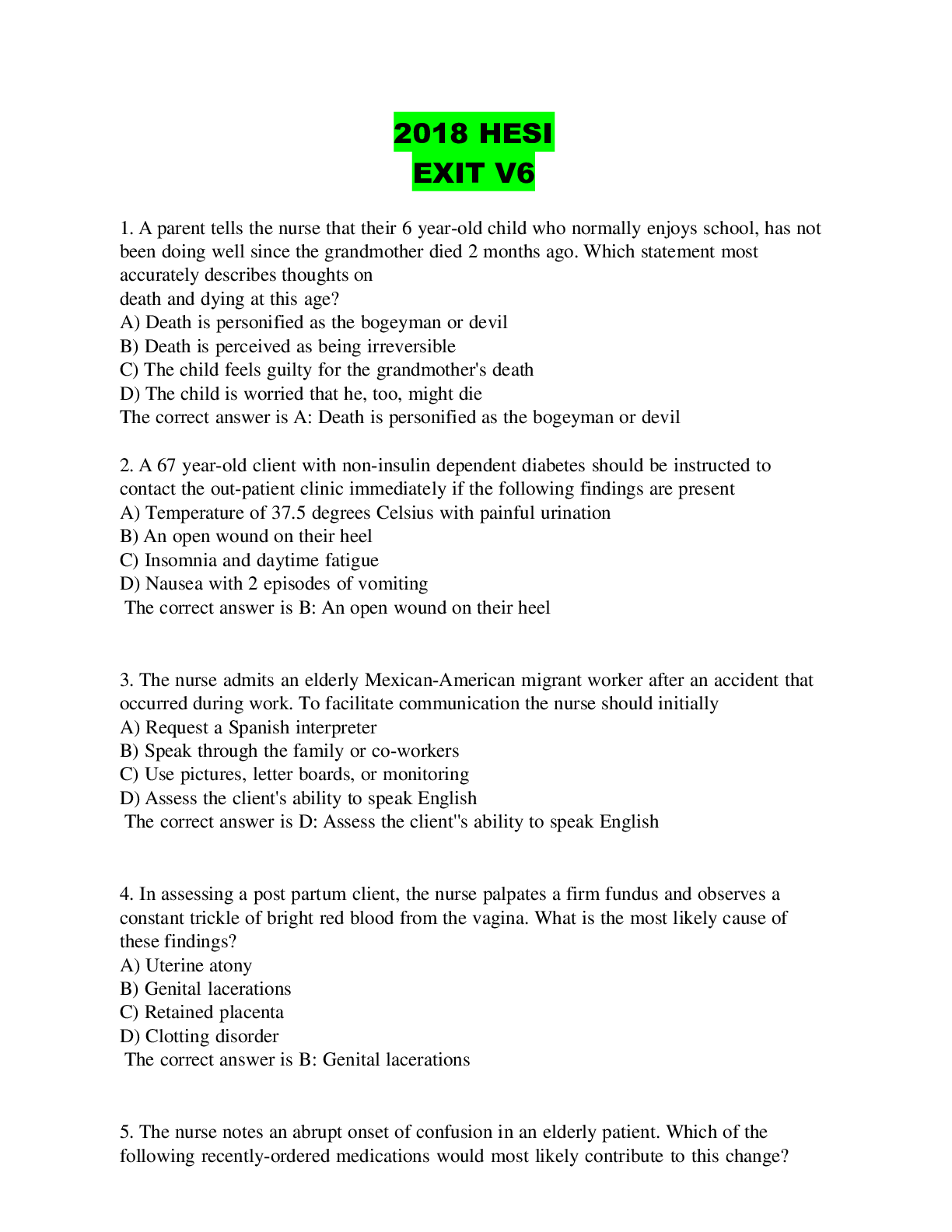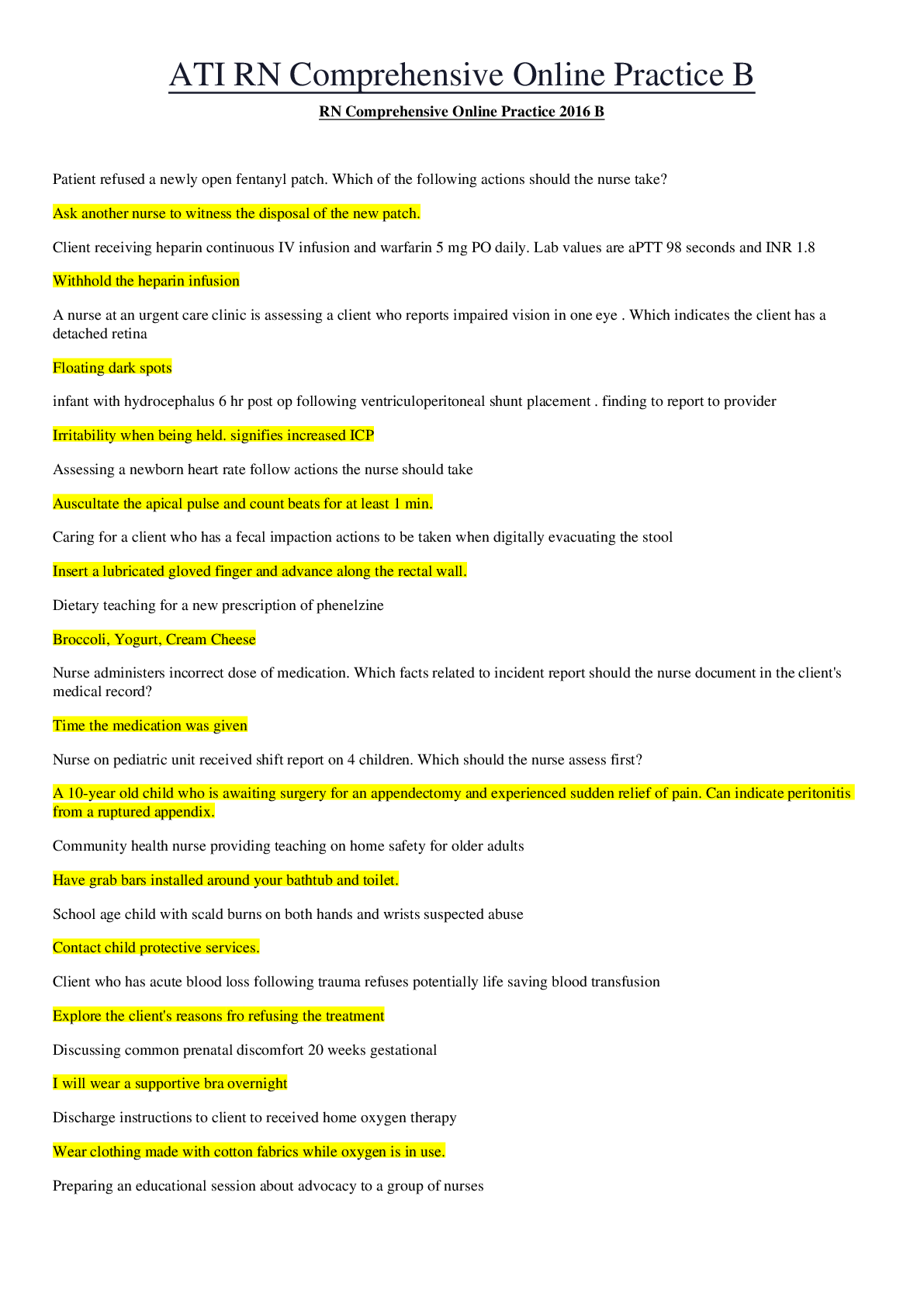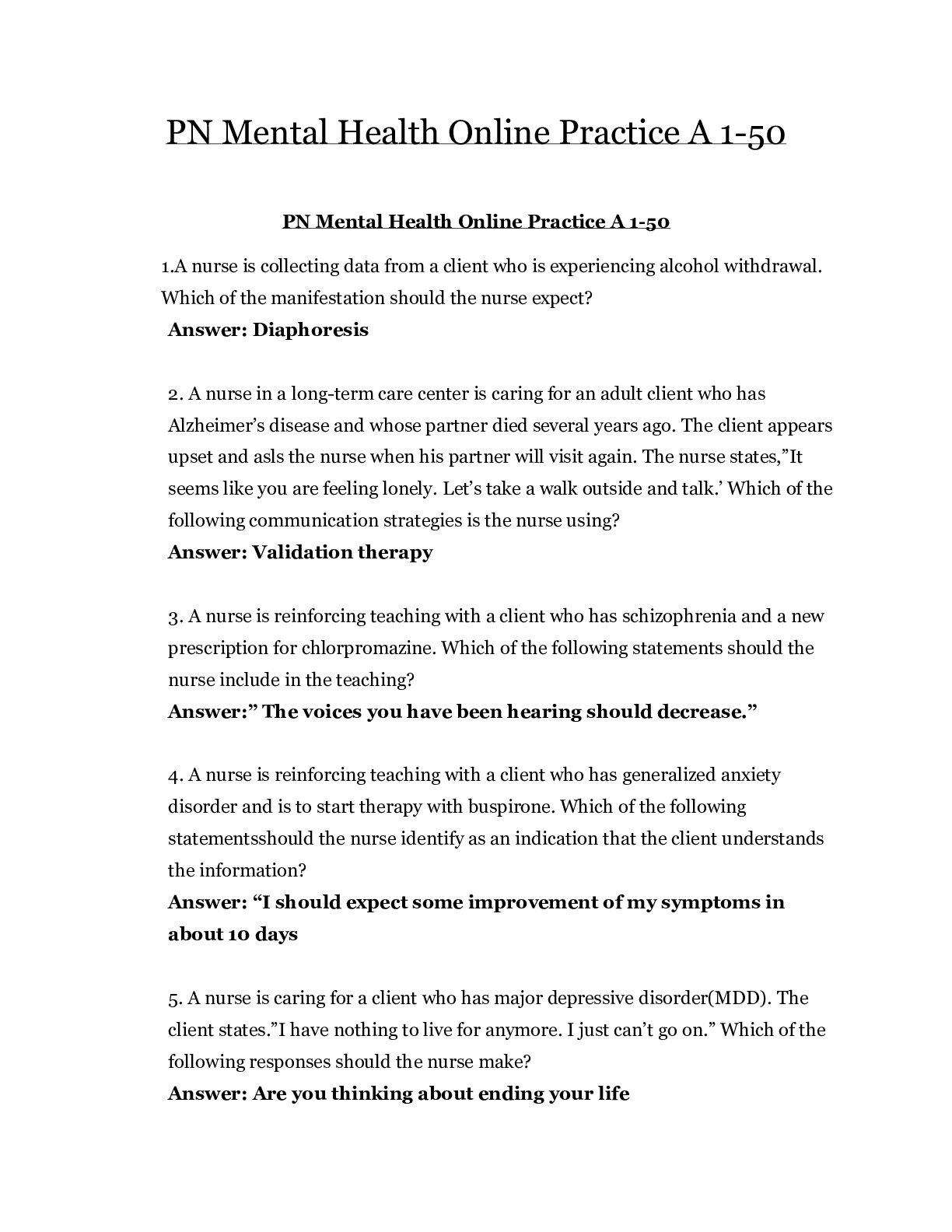Pathophysiology > EXAM > MN551 Advanced Pathophysiology Final Week 10 Exam. Kaplan University MN551 Final Week 10 Exam. 50 Q& (All)
MN551 Advanced Pathophysiology Final Week 10 Exam. Kaplan University MN551 Final Week 10 Exam. 50 Q&A.
Document Content and Description Below
MN551 Final week 10 During an examination, the nurse observes a female patient's vestibule and expects to see the: A ) urethral meatus and vaginal orifice. B) vaginal orifice and vestibular (... Bartholin) glands. C) urethral meatus and paraurethral (Skene) glands. D) paraurethral (Skene) and vestibular (Bartholin) glands. The labial structures encircle a boat-shaped space, or cleft, termed the vestibule. Within it are numerous openings. The urethral meatus and vaginal orifice are visible. The ducts of the paraurethral (Skene) glands and the vestibular (Bartholin) glands are present but not visible. During a speculum inspection of the vagina, the nurse would expect to see what at the end of the vaginal canal? A) Cervix B) Uterus C) Ovaries D) Fallopian tubes At the end of the canal, the uterine cervix projects into the vagina The uterus is usually positioned tilting forward and superior to the bladder. This position is known as: A) anteverted and anteflexed. B) retroverted and anteflexed. C retroverted and retroflexed. D)superiorverted and anteflexed. The uterus is freely movable, not fixed, and usually tilts forward and superior to the bladder (a position labeled as anteverted and anteflexed). An 11-year-old girl is in the clinic for a sports physical. The nurse notices that she has begun to develop breasts, and during the conversation the girl reveals that she is worried about her development. The nurse should use which of these techniques to best assist the young girl in understanding the expected sequence for development? The nurse should: A)use the Tanner's table on the five stages of sexual development. B) describe her development and compare it with that of other girls her age. C) use Jacobsen's table on expected development on the basis of height and weight data. D) reassure her that her development is within normal limits and should tell her not to worry about the next step. Tanner's table on the five stages of pubic hair development is helpful in teaching girls the expected sequence of sexual development (see Table 26-1). The other responses are not appropriate. A woman who is 8 weeks pregnant is in the clinic for a checkup. The nurse reads on her chart that her cervix is softened and looks cyanotic. The nurse knows that the woman is exhibiting _____ sign and _____ sign. A) Tanner's; Hegar's B)Hegar's; Goodell's C)Chadwick's; Hegar's D)Goodell's; Chadwick's Shortly after the first missed menstrual period, the female genitalia show signs of the growing fetus. The cervix softens (Goodell's sign) at 4 to 6 weeks, and the vaginal mucosa and cervix look cyanotic (Chadwick's sign) at 8 to 12 weeks. These changes occur because of increased vascularity and edema of the cervix and hypertrophy and hyperplasia of the cervical glands. Hegar's sign occurs when the isthmus of the uterus softens at 6 to 8 weeks. Tanner's sign is not a correct response. A woman who is 22 weeks pregnant has a vaginal infection. She tells the nurse that she is afraid that this infection will hurt the fetus. The nurse knows that which of these statements is true? A)If intercourse is avoided, then the risk for infection is minimal. B)A thick mucus plug forms that protects the fetus from infection. C)The acidic pH of vaginal secretions promotes the growth of pathogenic bacteria. D)The mucus plug that forms in the cervical canal is a good medium for bacterial growth. A clot of thick, tenacious mucus forms in the spaces of the cervical canal (the mucus plug), which protects the fetus from infection. Cervical and vaginal secretions increase during pregnancy and are thick, white, and more acidic. The acidic pH keeps pathogenic bacteria from multiplying in the vagina, but the increase in glycogen increases the risk of candidiasis (commonly called a yeast infection) during pregnancy. The changes normally associated with menopause occur generally because the cells in the reproductive tract are: A)aging. B)becoming fibrous. C)estrogen dependent. D)able to respond to estrogen. Because cells in the reproductive tract are estrogen dependent, decreased estrogen levels during menopause bring dramatic physical changes. The other options are not correct. The nurse is reviewing the changes that occur with menopause. Which of these are changes associated with menopause? A)Uterine and ovarian atrophy along with thinning vaginal epithelium B)Ovarian atrophy, increased vaginal secretions, and increasing clitoral size C) Cervical hypertrophy, ovarian atrophy, and increased acidity of vaginal secretions D) Vaginal mucosa fragility, increased acidity of vaginal secretions, and uterine hypertrophy ANS: A The uterus shrinks because of its decreased myometrium. The ovaries atrophy to 1 to 2 cm and are not palpable after menopause. The sacral ligaments relax, and the pelvic musculature weakens, so the uterus droops. The cervix shrinks and looks paler with a thick glistening epithelium. The vaginal epithelium atrophies, becoming thinner, drier, and itchy. The vaginal pH becomes more alkaline, and secretions are decreased. This results in a fragile mucosal surface that is at risk for bleeding and vaginitis. A 54-year-old woman who has just completed menopause is in the clinic today for a yearly physical examination. Which of these statements should the nurse include in patient education? "A postmenopausal woman: A) is not at any greater risk for heart disease than a younger woman is." B) should be aware that she is at increased risk for dyspareunia because of decreased vaginal secretions." C) has only stopped menstruating; there really are no other significant changes with which she should be concerned." D) is likely to have difficulty with sexual pleasure as a result of drastic changes in the female sexual response cycle." ANS: B Decreased vaginal secretions leave the vagina dry and at risk for irritation and pain with intercourse (dyspareunia). The other statements are incorrect. A woman is in the clinic for an annual gynecologic examination. The nurse should plan to begin the interview with the: A) menstrual history because it is generally nonthreatening. B) obstetric history because it is the most important information. C) urinary system history because there may be problems in this area as well. D) sexual history because it will build rapport to discuss this first. Menstrual history is usually nonthreatening; thus it is a good place to start. Obstetric, urinary, and sexual histories are also part of the interview but not necessarily the best topics with which to start. A patient has had three pregnancies and two live births. The nurse would record this information as gravida _____, para _____, AB _____. A) 2; 2; 1 B) 3; 2; 0 C) 3; 2; 1 D) 3; 3; 1 Gravida is number of pregnancies. Para is number of births. Abortions are interrupted pregnancies, including elective abortions and spontaneous miscarriages. During the interview with a female patient, the nurse gathers data that indicate that the patient is perimenopausal. Which of these statements made by this patient leads to this conclusion? A)"I have noticed that my muscles ache at night when I go to bed." B) "I will be very happy when I can stop worrying about having a period." C) "I have been noticing that I sweat a lot more than I used to, especially at night." D) "I have only been pregnant twice, but both times I had breast tenderness as my first symptom." Hormone shifts occur during the perimenopausal period, and associated symptoms of menopause may occur, such as hot flashes, night sweats, numbness and tingling, headache, palpitations, drenching sweats, mood swings, vaginal dryness, and itching. The other responses are not correct. A 50-year-old woman calls the clinic because she has noticed some changes in her body and breasts and wonders if they could be due to the hormone replacement therapy (HRT) she started 3 months ago. The nurse should tell her: A) "Hormone replacement therapy is at such a low dose that side effects are very unusual." B) "Hormone replacement therapy has several side effects, including fluid retention, breast tenderness, and vaginal bleeding." C) "It would be very unusual to have vaginal bleeding with hormone replacement therapy, and I suggest you come in to the clinic immediately to have this evaluated." D) "It sounds as if your dose of estrogen is too high; I think you may need to decrease the amount you are taking and then call back in a week." Side effects of hormone replacement therapy include fluid retention, breast pain, and vaginal bleeding. The other responses are not correct. A 52-year-old patient states that when she sneezes or coughs she "wets herself a little." She is very concerned that something may be wrong with her. The nurse suspects that the problem is: A) dysuria. B) stress incontinence. C) hematuria. D) urge incontinence. Stress incontinence is involuntary urine loss with physical strain, sneezing, or coughing. Dysuria is pain or burning with urination. Hematuria is bleeding with urination. Urge incontinence is involuntary urine loss but it occurs due to an overactive detrusor muscle in the bladder that contracts and causes an urgent need to void During the interview a patient reveals that she has some vaginal discharge. She is worried that it may be a sexually transmitted infection. The nurse's most appropriate response to this would be: A) "Oh, don't worry. Some cyclic vaginal discharge is normal." B) "Have you been engaging in unprotected sexual intercourse?" C) "I'd like some information about the discharge. What color is it?" D) "Have you had any urinary incontinence associated with the discharge?" Ask questions that help the patient reveal more information about her symptoms in a nonthreatening manner. Assess vaginal discharge further by asking about the amount, color, and odor. Normal vaginal discharge is small, clear or cloudy, and always nonirritating. A woman states that 2 weeks ago she had a urinary tract infection that was treated with an antibiotic. As a part of the interview, the nurse should ask, "Have you noticed: A) a change in your urination patterns?" B) any excessive vaginal bleeding?" C) any unusual vaginal discharge or itching?" D) any changes in your desire for intercourse?" Several medications may increase the risk of vaginitis. Broad-spectrum antibiotics alter the balance of normal flora, which may lead to the development of vaginitis. The other questions are not correct Which statement would be most appropriate when the nurse is introducing the topic of sexual relationships during an interview? A)"Now it is time to talk about your sexual history. When did you first have intercourse?" B) "Women often feel dissatisfied with their sexual relationships. Would it be okay to discuss this now?" C) "Often women have questions about their sexual relationship and how it affects their health. Do you have any questions?" D) "Most women your age have had more than one sexual partner. How many would you say you have had?" The nurse should begin with an open-ended question to assess individual needs. The nurse should include appropriate questions as a routine part of the history, because doing so communicates that the nurse accepts the individual's sexual activity and believes it is important. The nurse's comfort with discussion prompts the patient's interest and possibly relief that the topic has been introduced. This establishes a database for comparison with any future sexual activities and provides an opportunity to screen sexual problems. A 22-year-old woman has been considering using oral contraceptives. As a part of her history, the nurse should ask: A) "Do you have a history of heart murmurs?" B) "Will you be in a monogamous relationship?" C) "Have you thought this choice through carefully?" D) "If you smoke, how many cigarettes do you smoke per day?" Oral contraceptives, together with cigarette smoking, increase the risk for cardiovascular side effects. If cigarettes are used, then the nurse should assess smoking history. The other questions are not appropriate. A married couple has come to the clinic seeking advice on pregnancy. They have been trying to conceive for 4 months and have not been successful. What should the nurse do first? A) Ascertain whether either of them has been using broad-spectrum antibiotics. B) Explain that couples are considered infertile after 1 year of unprotected intercourse. C) Immediately refer the woman to an expert in pelvic inflammatory disease—the most common cause of infertility. D) Explain that couples are considered infertile after 3 months of engaging in unprotected intercourse and that they will need a referral to a fertility expert. Infertility is considered after 1 year of engaging in unprotected sexual intercourse without conceiving. The other actions are not appropriate A nurse is assessing a patient's risk of contracting a sexually transmitted infection (STI). An appropriate question to ask would be: A) "You know that it's important to use condoms for protection, right?" B) "Do you use a condom with each episode of sexual intercourse?" C) "Do you have a sexually transmitted infection?" D) "You are aware of the dangers of unprotected sex, aren't you?" In reviewing a patient's risk for sexually transmitted infections, the nurse should ask, in a nonconfrontational manner, whether condoms are used at each episode of sexual intercourse. Asking a person whether he or she has an infection does not address the risk. When the nurse is interviewing a preadolescent girl, which opening statement would be least threatening? A) "Do you have any questions about growing up?" B) "What has your mother told you about growing up?" C) "When did you notice that your body was changing?" D) "I remember being very scared when I got my period. How do you think you'll feel?" Try the open-ended, "When did you ... ?" rather than "Do you ... ?" This is less threatening because it implies that the topic is normal and unexceptional. When the nurse is discussing sexuality and sexual issues with adolescents, a permission statement helps to convey that it is normal to think or feel a certain way. Which of these is the best example of a permission statement? A) "It is okay that you have become sexually active." B) "Often girls your age have questions about sexual activity. Have you any questions?" C) "If it is okay with you, I'd like to ask you some questions about your sexual history." D) "Often girls your age engage in sexual activity. It is okay to tell me if you have had intercourse." Start with a permission statement, "Often girls your age experience . . . ." This conveys that it is normal to think or feel a certain way, and it is important to relay that the topic is normal and unexceptional. The nurse is preparing to interview a postmenopausal woman. Which of these statements is true with regard to the history of a postmenopausal woman? A) The nurse should ask a postmenopausal woman if she ever has vaginal bleeding. B) Once a woman reaches menopause, the nurse does not need to ask any further history questions. C) The nurse should screen for monthly breast tenderness. D) Postmenopausal women are not at risk for contracting sexually transmitted infections and thus these questions can be omitted. Postmenopausal bleeding warrants further workup and referral. The other statements are not true. During the examination portion of a patient's visit, she will be in lithotomy position. Which statement below reflects some things that the nurse can do to make this more comfortable for her? A) Ask her to place her hands and arms behind her head. B) Elevate her head and shoulders to maintain eye contact. C) Allow her to choose to have her feet in the stirrups or have them resting side by side on the edge of the table. D) Allow her to keep her buttocks about 6 inches from the edge of the table to prevent her from feeling as if she will fall off. The nurse should elevate her head and shoulders to maintain eye contact. The patient's arms should be placed at her sides or across the chest, not behind the head, because this position only tightens the abdominal muscles. The feet should be placed into the stirrups, knees apart, and buttocks at the edge of the examining table. Place the stirrups so the legs are not abducted too far An 18-year-old patient is having her first pelvic examination. Which action by the nurse is appropriate? A) Invite her mother to be present during the examination. B) Avoid the lithotomy position this first time because it can be uncomfortable and embarrassing. C) Raise the head of the examination table and give her a mirror so that she can view the exam. D) Drape her fully, leaving the drape between her legs elevated to avoid embarrassing her with eye contact. Use the techniques of the educational or mirror pelvic examination. This is a routine examination with some modifications in attitude, position, and communication. First, the woman is considered an active participant, one who is interested in learning and in sharing decisions about her own health care. The woman props herself up on one elbow, or the head of the table is raised. Her other hand holds a mirror between her legs, above the examiner's hands. The woman can see all that the examiner is doing and has a full view of her genitalia. The mirror works well for teaching normal anatomy and its relationship to sexual behavior. You can ask her if she would like to have a family member, friend, or chaperone present for the examination. The drape should be pushed down between the woman's legs so that the nurse can see her face. The nurse has just completed an inspection of a nulliparous woman's external genitalia. Which of these would be a description of a finding within normal limits? A) Redness of the labia majora B) Multiple nontender sebaceous cysts C) Discharge that is sticky and yellow-green There should be no lesions, except for occasional sebaceous cysts. These are yellowish 1-cm nodules that are firm, nontender, and often multiple. The labia majora are dark pink, moist, and symmetrical; redness indicates inflammation or lesions. Discharge that is sticky and yellow-green may indicate infection. In the nulliparous woman, the labia majora meet in the midline, are symmetric and plump. The nurse is preparing for an internal genitalia examination of a woman. Which order of the examination is correct? A) Bimanual, speculum, rectovaginal B) Speculum, rectovaginal, bimanual C) Speculum, bimanual, rectovaginal D) Rectovaginal, bimanual, speculum The correct sequence is speculum examination, then bimanual examination after removing the speculum, and then rectovaginal examination. The examiner should change gloves before performing the rectovaginal examination to avoid spreading any possible infection During an internal examination of a woman's genitalia, the nurse will use which technique for proper insertion of the speculum? A) Instruct the woman to bear down, open the speculum blades, and apply in a swift, upward movement. B) Insert the blades of the speculum on a horizontal plane, turning them to a 30-degree angle while continuing to insert them. Ask the woman to bear down after the speculum is inserted. C) Instruct the woman to bear down, turn the width of the blades horizontally, and insert the speculum at a 45-degree angle downward toward the small of the woman's back. D) Lock the blades open by turning the thumbscrew. Once the blades are open, apply pressure to the introitus and insert the blades at a 45-degree angle downward to bring the cervix into view. The examiner should instruct the woman to bear down, turn the width of the blades horizontally, and insert the speculum at a 45-degree angle downward toward the small of the woman's back. See the text under "Speculum Examination" for more detail. The nurse is examining a 35-year-old female patient. During the history, the nurse notices that she has had two term pregnancies, and both babies were delivered vaginally. During the internal examination the nurse observes that the cervical os is a horizontal slit with some healed lacerations and that the cervix has some nabothian cysts that are small, smooth, and yellow. In addition, the nurse notices that the cervical surface is granular and red, especially around the os. Finally, the nurse notices the presence of stringy, opaque, odorless secretions. Which of these findings are abnormal? A) Nabothian cysts are present. B) The cervical os is a horizontal slit. C) The cervical surface is granular and red. D) Stringy and opaque secretions are present. Normal findings: Nabothian cysts may be present on the cervix after childbirth. The cervical os is a horizontal, irregular slit in the parous woman. Secretions vary according to the day of the menstrual cycle, and may be clear and thin or thick, opaque, and stringy. The surface is normally smooth, but cervical eversion, or ectropion may occur where the endocervical canal is "rolled out." Abnormal finding: The cervical surface should not be reddened or granular, which may indicate a lesion. A patient calls the clinic for instructions before having a Papanicolaou (Pap) smear. The most appropriate instructions from the nurse are: A) "If you are menstruating, please use pads to avoid placing anything into the vagina." B) "Avoid intercourse, inserting anything into the vagina, or douching within 24 hours of your appointment." C) "If you suspect that you have a vaginal infection, please gather a sample of the discharge to bring with you." D) "We would like you to use a mild saline douche before your examination. You may pick this up in our office." When instructing a patient before a Papanicolaou (Pap) smear is obtained, the nurse should follow these guidelines: Do not obtain during the woman's menses or if a heavy infectious discharge is present. Instruct the woman not to douche, have intercourse, or put anything into the vagina within 24 hours before collecting the specimens. Any specimens will be obtained during the visit, not beforehand. During an examination, which tests will the nurse collect to screen for cervical cancer? A) Endocervical specimen, cervical scrape, and vaginal pool B) Endocervical specimen, vaginal pool, and acetic acid wash C) Endocervical specimen, KOH preparation, and acetic acid wash D) Cervical scrape, acetic acid wash, saline mount ("wet prep") Laboratories may vary in method, but usually the test consists of three specimens: endocervical specimen, cervical scrape, and vaginal pool. The other tests (acetic acid wash, KOH preparation, and saline mount) are used to test for sexually transmitted infections When performing the bimanual examination, the nurse notices that the cervix feels smooth and firm, is round, and is fixed in place (does not move). When cervical palpation is performed, the patient complains of some pain. The nurse's interpretation of these results should be which of these? A) These findings are all within normal limits. B) The cervical consistency should be soft and velvety—not firm. C) The cervix should move when palpated; an immobile cervix may indicate malignancy. D) Pain may occur during palpation of the cervix. Normally the cervix feels smooth and firm, as the consistency of the tip of the nose. It softens and feels velvety at 5 to 6 weeks of pregnancy (Goodell's sign). The cervix should be evenly rounded. With a finger on either side, the examiner should be able to move the cervix gently from side to side, and doing so should produce no pain for the patient. Hardness of the cervix may occur with malignancy. Immobility may occur with malignancy, and pain may occur with inflammation or ectopic pregnancy. The nurse is palpating a female patient's adnexa. The findings include a firm, smooth uterine wall; the ovaries are palpable and feel smooth and firm. The fallopian tube is firm and pulsating. The nurse's most appropriate course of action would be to: A) tell the patient that her examination was normal. B) give her an immediate referral to a gynecologist. C) suggest that she return in a month for a recheck to verify the findings. D) tell the patient that she may have an ovarian cyst that should be evaluated further. Normally the uterine wall feels firm and smooth, with the contour of the fundus rounded. Ovaries are not often palpable, but when they are, they normally feel smooth, firm, and almond shaped and are highly movable, sliding through the fingers. The fallopian tube is not palpable normally. No other mass or pulsation should be felt. Pulsation or palpable fallopian tube suggests ectopic pregnancy, which warrants immediate referral A 65-year-old woman is in the office for routine gynecologic care. She had a complete hysterectomy 3 months ago after cervical cancer was detected. The nurse knows that which of these statements is true with regard to this visit? A) Her cervical mucosa will be red and dry looking. B) She will not need to have a Pap smear done. C) The nurse can expect to find that her uterus will be somewhat enlarged and her ovaries small and hard. D) The nurse should plan to lubricate the instruments and the examining hand well to avoid a painful examination. In the aging adult woman, natural lubrication is decreased; to avoid a painful examination, the nurse should take care to lubricate instruments and the examining hand adequately. Menopause, with the resulting decrease in estrogen production, shows numerous physical changes. The cervix shrinks and looks pale and glistening. With the bimanual examination, the uterus feels smaller and firmer and the ovaries are not palpable normally. Women should continue cervical cancer screening up to age 70 years if they have an intact cervix and are in good health. Women who have had a total hysterectomy for benign gynecologic disease do not need cervical cancer screening, but if the hysterectomy was done for cervical cancer, then Pap tests should continue until the patient has a 10-year history of no abnormal results. The nurse is preparing to examine the external genitalia of a school-age girl. Which of these positions would be most appropriate in this situation? A) In the parent's lap B) In a frog-leg position on the examining table C) In the lithotomy position with the feet in stirrups D) Lying flat on the examining table with legs extended For school-age children it is best to place them on the examining table in a frog-leg position. With toddlers and preschoolers, it is best to have the child on the parent's lap in a frog-leg position. When assessing a newborn infant's genitalia, the nurse notices that the genitalia are somewhat engorged. The labia majora are swollen, the clitoris looks large, and the hymen is thick. The vaginal opening is difficult to visualize. The infant's mother states that she is worried about the labia being swollen. The nurse should reply: A) "This is a normal finding in newborns and should resolve within a few weeks." B "This could indicate an abnormality and may need to be evaluated by a physician." C) "We will need to have estrogen levels evaluated to make sure that they are within normal limits." D) "We will need to keep close watch over the next few days to see if the genitalia decrease in size." It is normal for a newborn's genitalia to be somewhat engorged. A sanguineous vaginal discharge or leukorrhea is normal during the first few weeks because of the maternal estrogen effect. During the early weeks, the genital engorgement resolves, and the labia minora atrophy and remain small until puberty. During a vaginal examination of a 38-year-old woman, the nurse notices that the vulva and vagina are erythematous and edematous with thick, white, curdlike discharge adhering to the vaginal walls. The woman reports intense pruritus and thick white discharge from her vagina. The nurse knows that these history and physical examination findings are most consistent with which of these conditions? A) Candidiasis B) Trichomoniasis C) Atrophic vaginitis D) Bacterial vaginosis The woman with candidiasis often reports intense pruritus and thick white discharge. The vulva and vagina are erythematous and edematous. The discharge is usually thick, white, and curdlike. Infection with trichomoniasis causes a profuse, watery, gray-green, and frothy discharge. Bacterial vaginosis causes a profuse discharge that has a "foul, fishy, rotten" odor. Atrophic vaginitis may have a mucoid discharge. See Table 26-5 for complete descriptions of each option. A 22-year-old woman is being seen at the clinic for problems with vulvar pain, dysuria, and fever. On physical examination, the nurse notices clusters of small, shallow vesicles with surrounding erythema on the labia. There is also inguinal lymphadenopathy present. The most likely cause of these lesions is: A) pediculosis pubis. B) contact dermatitis. C) human papillomavirus. D) herpes simplex virus type 2. Herpes simplex virus type 2 presents with clusters of small, shallow vesicles with surrounding erythema that erupt on the genital areas. There is also the presence of inguinal lymphadenopathy. The individual reports local pain, dysuria, and fever. See Table 26-2 for more information and descriptions of the other conditions. When performing an external genitalia examination of a 10-year-old girl, the nurse notices that there is no pubic hair, and the mons and the labia are covered with fine vellus hair. These findings are consistent with stage _____ of sexual maturity, according to the Sexual Maturity Rating scale. A) 1 B) 2 C) 3 D) 4 Sexual Maturity Rating stage 1 is the preadolescent stage. There is no pubic hair. The mons and labia are covered with fine, vellus hair as on the abdomen. See Table 26-1. A 46-year-old woman is in the clinic for her annual gynecologic examination. She voices a concern about ovarian cancer because her mother and sister died of it. The nurse knows that which of these statements is correct regarding ovarian cancer? A) Ovarian cancer rarely has any symptoms. B) The Pap smear detects the presence of ovarian cancer. C) Women at high risk for ovarian cancer should have annual transvaginal ultrasonography for screening. D) Women over age 40 years should have a thorough pelvic examination every 3 years. With ovarian cancer, the patient may have abdominal pain, pelvic pain, increased abdominal size, bloating, and nonspecific gastrointestinal symptoms, or she may be asymptomatic. The Pap smear does not detect the presence of ovarian cancer. Annual transvaginal ultrasonography may detect ovarian cancer at an earlier stage in women who are at high risk for it. During a bimanual examination, the nurse detects a solid tumor on the ovary that is heavy and fixed, with a poorly defined mass. This finding is suggestive of: A) an ovarian cyst. B) endometriosis. C) ovarian cancer. D) an ectopic pregnancy. Ovarian tumors that are solid, heavy, and fixed, with poorly defined mass are suggestive of malignancy. Benign masses may feel mobile and solid. An ovarian cyst may feel smooth, round, fluctuant, mobile, and nontender. With an ectopic pregnancy, the examiner may feel a palpable, tender pelvic mass that is solid, mobile, and unilateral. Endometriosis may have masses (in various locations in the pelvic area) that are small, firm, nodular and tender to palpation, with enlarged ovaries. A 25-year-old woman comes to the emergency department with a sudden fever of 101° F and abdominal pain. Upon examination, the nurse notices that she has rigid, boardlike lower abdominal musculature. When the nurse tries to perform a vaginal examination, the patient has severe pain when the uterus and cervix are moved. The nurse knows that these signs and symptoms are suggestive of: A) endometriosis. B) uterine fibroids. C) ectopic pregnancy. D) pelvic inflammatory disease. These signs and symptoms are suggestive of acute pelvic inflammatory disease, also known as acute salpingitis. See Table 26-7. For description of endometriosis and uterine fibroids, see Table 26-6; for description of ectopic pregnancy, see Table 26-7. During an external genitalia examination of a woman, the nurse notices several lesions around the vulva. The lesions are pink, moist, soft, and pointed papules. The patient states that she is not aware of any problems in that area. The nurse recognizes that these lesions may be: A) syphilitic chancre. B) herpes simplex virus type 2 (herpes genitalis). C) human papillomavirus (HPV), or genital warts. D) pediculosis pubis (crab lice). HPV lesions are painless, warty growths that the woman may not notice. Lesions are pink or flesh colored, soft, pointed, moist, warty papules that occur in single or multiple cauliflower-like patches around the vulva, introitus, anus, vagina, or cervix. Herpetic lesions are painful clusters of small, shallow vesicles with surrounding erythema. Syphilitic chancres begin as a solitary silvery papule that erodes to a red, round or oval, superficial ulcer with a yellowish discharge. Pediculosis pubis causes severe perineal itching and excoriations and erythematous areas. See Table 26-2. During an examination, the nurse would expect the cervical os of a woman who has never had children to appear: A) stellate. B) small and round. C) as a horizontal irregular slit. D) everted. The cervical os in a nulliparous woman is small and round. In the parous woman, it is a horizontal, irregular slit that also may show healed lacerations on the sides. See Figure 26-13. A woman has just been diagnosed with HPV, or genital warts. The nurse should counsel her to receive regular examinations because this virus makes her at a higher risk for _____ cancer. A) uterine B) cervical C) ovarian D) endometrial HPV is the virus responsible for most cases of cervical cancer, not the other options. During an internal examination, the nurse notices that the cervix bulges outside the introitus when the patient is asked to strain. The nurse will document this as: A) uterine prolapse, graded first degree. B) uterine prolapse, graded second degree. C) uterine prolapse, graded third degree. D) a normal finding. The cervix should not be found to bulge into the vagina. Uterine prolapse is graded as follows: first degree—cervix appears at introitus with straining; second degree—cervix bulges outside introitus with straining; and third degree—whole uterus protrudes, even without straining (essentially, uterus is inside out). A 35-year-old woman is at the clinic for a gynecologic examination. During the examination, she asks the nurse, "How often do I need to have this Pap test done?" Which reply by the nurse is correct? A)"It depends. Do you smoke?" B)"This will need to be done annually until you are 65." C)"If you have 2 consecutive normal Pap tests, then you can wait 5 years between tests." D)"After age 30, if you have 3 consecutive normal Pap tests, then you may be screened every 2 to 3 years." Cervical cancer screening with the Pap test continues annually until age 30. After age 30, if the woman has 3 consecutive normal Pap tests, then women may be screened every 2 to 3 years. The nurse is palpating an ovarian mass during an internal examination of a 63-year-old woman. Which findings of the mass's characteristics would suggest the presence of an ovarian cyst? Select all that apply. A) Heavy and solid B) Mobile and fluctuant C)Mobile and solid D) Fixed E) Smooth and round F) Poorly defined An ovarian cyst (fluctuant ovarian mass) is usually asymptomatic, and would feel like a smooth, round, fluctuant, mobile, nontender mass on the ovary. A mass that is heavy, solid, fixed, and poorly defined suggests malignancy. A benign mass may feel mobile and solid. [Show More]
Last updated: 9 months ago
Preview 1 out of 24 pages
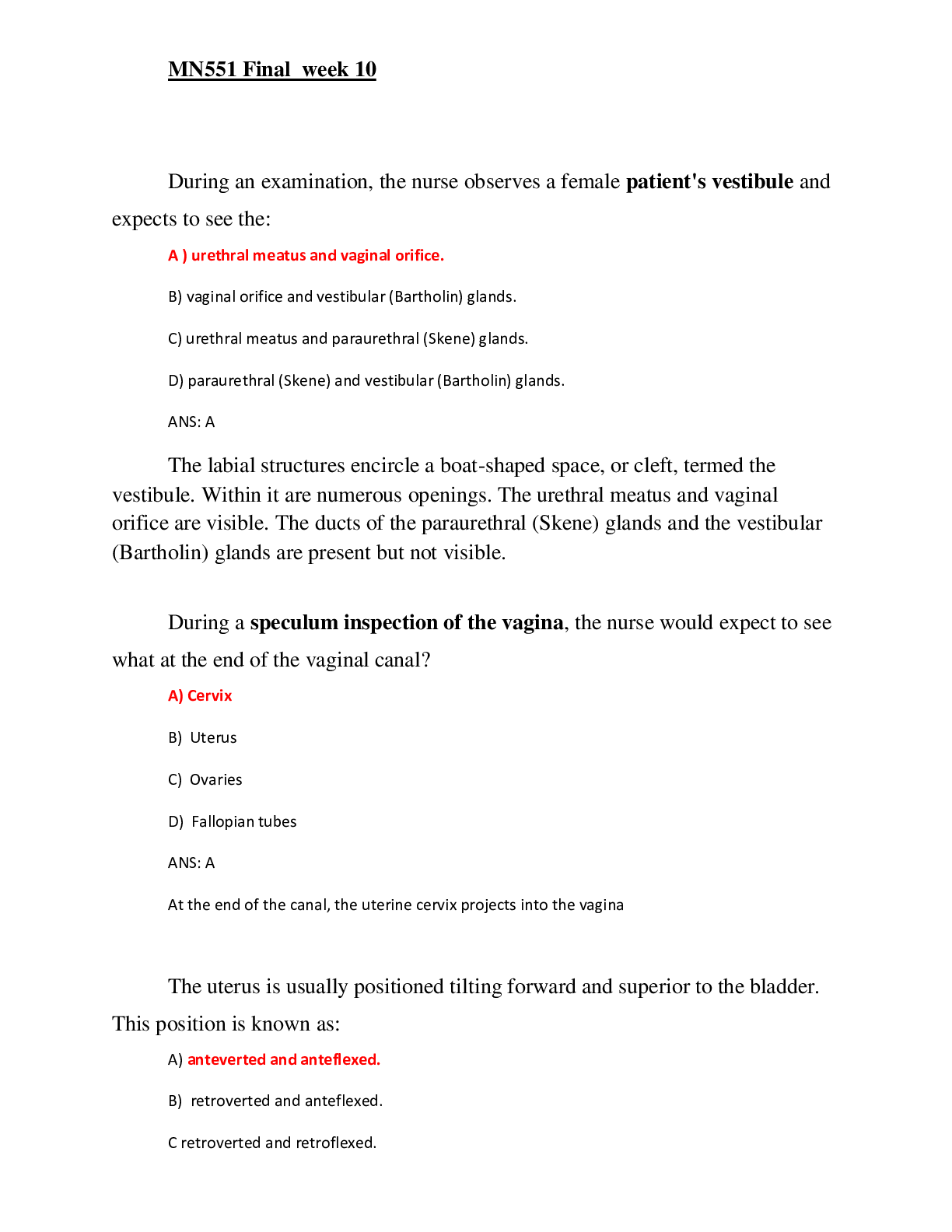
Reviews( 0 )
Document information
Connected school, study & course
About the document
Uploaded On
Nov 13, 2019
Number of pages
24
Written in
Additional information
This document has been written for:
Uploaded
Nov 13, 2019
Downloads
1
Views
115

